1. Gaviria L, Salcido JP, Guda T, Ong JL. Current trends in dental implants. J Korean Assoc Oral Maxillofac Surg. 2014; 40:50–60. PMID:
24868501.

2. Chee W, Jivraj S. Failures in implant dentistry. Br Dent J. 2007; 202:123–129. PMID:
17293814.

3. Di Iorio D, Sinjari B, Feragalli B, Murmura G. Biomechanical aspects in late implant failures: scanning electron microscopy analysis of four clinical cases. J Contemp Dent Pract. 2011; 12:356–360. PMID:
22269196.
4. Weber HP, Sukotjo C. Does the type of implant prosthesis affect outcomes in the partially edentulous patient? Int J Oral Maxillofac Implants. 2007; 22:140–172. PMID:
18437795.
5. Gracis S, Michalakis K, Vigolo P, Vult von Steyern P, Zwahlen M, Sailer I. Internal vs. external connections for abutments/reconstructions: a systematic review. Clin Oral Implants Res. 2012; 23:202–216. PMID:
23062143.

6. Sailer I, Mühlemann S, Zwahlen M, Hämmerle CH, Schneider D. Cemented and screw-retained implant reconstructions: a systematic review of the survival and complication rates. Clin Oral Implants Res. 2012; 23:163–201. PMID:
23062142.

7. Theoharidou A, Petridis HP, Tzannas K, Garefis P. Abutment screw loosening in single-implant restorations: a systematic review. Int J Oral Maxillofac Implants. 2008; 23:681–690. PMID:
18807565.
8. Vigolo P, Gracis S, Carboncini F, Mutinelli S. AIOP (Italian Academy of Prosthetic Dentistry) clinical research group. Internal-vs external-connection single implants: A retrospective study in an italian population treated by certified prosthodontists. Int J Oral Maxillofac Implants. 2016; 31:1385–1396. PMID:
27861666.
9. Katsuta Y, Watanabe F. Abutment screw loosening of endosseous dental implant body/abutment joint by cyclic torsional loading test at the initial stage. Dent Mater J. 2015; 34:896–902. PMID:
26632240.

10. Sakamoto K, Homma S, Takanashi T, Takemoto S, Furuya Y, Yoshinari M, Yajima Y. Influence of eccentric cyclic loading on implant components: Comparison between external joint system and internal joint system. Dent Mater J. 2016; 35:929–937. PMID:
27725367.

11. Khraisat A, Hashimoto A, Nomura S, Miyakawa O. Effect of lateral cyclic loading on abutment screw loosening of an external hexagon implant system. J Prosthet Dent. 2004; 91:326–334. PMID:
15116033.

12. Tsuge T, Hagiwara Y. Influence of lateral-oblique cyclic loading on abutment screw loosening of internal and external hexagon implants. Dent Mater J. 2009; 28:373–381. PMID:
19721272.

13. Gupta S, Gupta H, Tandan A. Technical complications of implant-causes and management: A comprehensive review. Natl J Maxillofac Surg. 2015; 6:3–8. PMID:
26668445.

14. do Nascimento C, Miani PK, Pedrazzi V, Gonçalves RB, Ribeiro RF, Faria AC, Macedo AP, de Albuquerque RF Jr. Leakage of saliva through the implant-abutment interface: in vitro evaluation of three different implant connections under unloaded and loaded conditions. Int J Oral Maxillofac Implants. 2012; 27:551–560. PMID:
22616048.
15. Taylor TD. Prosthodontic problems and limitations associated with osseointegration. J Prosthet Dent. 1998; 79:74–78. PMID:
9474545.

16. Stüker RA, Teixeira ER, Beck JC, da Costa NP. Preload and torque removal evaluation of three different abutment screws for single standing implant restorations. J Appl Oral Sci. 2008; 16:55–58. PMID:
19089290.

17. Winkler S, Ring K, Ring JD, Boberick KG. Implant screw mechanics and the settling effect: overview. J Oral Implantol. 2003; 29:242–245. PMID:
14620687.
18. Dhingra A, Weiner S, Luke AC, Ricci JL. Analysis of dimensional changes in the screw and the surface topography at the interface of a titanium screw and a zirconia abutment under cyclic loading: an in vitro study. Int J Oral Maxillofac Implants. 2013; 28:661–669. PMID:
23748295.

19. Siamos G, Winkler S, Boberick KG. Relationship between implant preload and screw loosening on implant-supported prostheses. J Oral Implantol. 2002; 28:67–73. PMID:
12498448.
20. Yeo IS, Lee JH, Kang TJ, Kim SK, Heo SJ, Koak JY, Park JM, Lee SY. The effect of abutment screw length on screw loosening in dental implants with external abutment connections after thermocycling. Int J Oral Maxillofac Implants. 2014; 29:59–62. PMID:
24451854.

21. Kim BJ, Yeo IS, Lee JH, Kim SK, Heo SJ, Koak JY. The effect of screw length on fracture load and abutment strain in dental implants with external abutment connections. Int J Oral Maxillofac Implants. 2012; 27:820–823. PMID:
22848883.
22. ISO 14801. Dentistry - Implants - Dynamic fatigue test for endosseous dental implants. Geneva, Switzerland: International Organization for Standardization;2007.
23. Khraisat A, Abu-Hammad O, Dar-Odeh N, Al-Kayed AM. Abutment screw loosening and bending resistance of external hexagon implant system after lateral cyclic loading. Clin Implant Dent Relat Res. 2004; 6:157–164. PMID:
15726850.

24. Pjetursson BE, Thoma D, Jung R, Zwahlen M, Zembic A. A systematic review of the survival and complication rates of implant-supported fixed dental prostheses (FDPs) after a mean observation period of at least 5 years. Clin Oral Implants Res. 2012; 23:22–38.
25. Bianco G, Di Raimondo R, Luongo G, Paoleschi C, Piccoli P, Piccoli C, Rangert B. Osseointegrated implant for singletooth replacement: a retrospective multicenter study on routine use in private practice. Clin Implant Dent Relat Res. 2000; 2:152–158. PMID:
11359260.

26. Jemt T, Pettersson P. A 3-year follow-up study on single implant treatment. J Dent. 1993; 21:203–208. PMID:
8354744.

27. Att W, Kurun S, Gerds T, Strub JR. Fracture resistance of single-tooth implant-supported all-ceramic restorations: an in vitro study. J Prosthet Dent. 2006; 95:111–116. PMID:
16473084.

28. Mohammed HH, Lee JH, Bae JM, Cho HW. Effect of abutment screw length and cyclic loading on removal torque in external and internal hex implants. J Adv Prosthodont. 2016; 8:62–69. PMID:
26949489.

29. Craig RG. Restorative dental materials. 9th ed. Mosby, St. Louis: 1993. p. 75–77.
30. Dittmer MP, Dittmer S, Borchers L, Kohorst P, Stiesch M. Influence of the interface design on the yield force of the implant-abutment complex before and after cyclic mechanical loading. J Prosthodont Res. 2012; 56:19–24. PMID:
21398198.

31. Mericske-Stern R, Zarb GA. In vivo measurements of some functional aspects with mandibular fixed prostheses supported by implants. Clin Oral Implants Res. 1996; 7:153–161. PMID:
9002834.

32. Alkan I, Sertgöz A, Ekici B. Influence of occlusal forces on stress distribution in preloaded dental implant screws. J Prosthet Dent. 2004; 91:319–325. PMID:
15116032.

33. Choi JH, Yang JH, Cho WP, Lee JB. The influence of abutment screw length and repeated tightening on screw loosening in dental implant. J Korean Acad Prosthodont. 2006; 44:432–442.
34. Sopwith DG. The distribution of load in screw threads. Proc Inst Mech Eng. 1948; 159:373–383.

35. Jemt T. Failures and complications in 391 consecutively inserted fixed prostheses supported by Brånemark implants in edentulous jaws: a study of treatment from the time of prosthesis placement to the first annual checkup. Int J Oral Maxillofac Implants. 1991; 6:270–276. PMID:
1813395.
36. Jemt T, Lindén B, Lekholm U. Failures and complications in 127 consecutively placed fixed partial prostheses supported by Brånemark implants: from prosthetic treatment to first annual checkup. Int J Oral Maxillofac Implants. 1992; 7:40–44. PMID:
1398822.

37. Luterbacher S, Fourmousis I, Lang NP, Brägger U. Fractured prosthetic abutments in osseointegrated implants: a technical complication to cope with. Clin Oral Implants Res. 2000; 11:163–170. PMID:
11168207.

38. Yi Y, Koak JY, Kim SK, Lee SJ, Heo SJ. Comparison of implant component fractures in external and internal type: A 12-year retrospective study. J Adv Prosthodont. 2018; 10:155–162. PMID:
29713437.

39. Binon PP. The effect of implant/abutment hexagonal misfit on screw joint stability. Int J Prosthodont. 1996; 9:149–160. PMID:
8639238.
40. McGlumphy EA, Mendel DA, Holloway JA. Implant screw mechanics. Dent Clin North Am. 1998; 42:71–89. PMID:
9421671.
41. Dixon DL, Breeding LC, Sadler JP, McKay ML. Comparison of screw loosening, rotation, and deflection among three implant designs. J Prosthet Dent. 1995; 74:270–278. PMID:
7473281.

42. Coppedê AR, Faria AC, de Mattos Mda G, Rodrigues RC, Shibli JA, Ribeiro RF. Mechanical comparison of experimental conical-head abutment screws with conventional flat-head abutment screws for external-hex and internal tri-channel implant connections: an in vitro evaluation of loosening torque. Int J Oral Maxillofac Implants. 2013; 28:e321–e329. PMID:
24278937.

43. Shin HM, Huh JB, Yun MJ, Jeon YC, Chang BM, Jeong CM. Influence of the implant-abutment connection design and diameter on the screw joint stability. J Adv Prosthodont. 2014; 6:126–132. PMID:
24843398.

44. Feitosa PC, de Lima AP, Silva-Concílio LR, Brandt WC, Neves AC. Stability of external and internal implant connections after a fatigue test. Eur J Dent. 2013; 7:267–271. PMID:
24926204.

45. Assunção WG, Delben JA, Tabata LF, Barão VA, Gomes EA, Garcia IR Jr. Preload evaluation of different screws in external hexagon joint. Implant Dent. 2012; 21:46–50. PMID:
22228458.

46. Maeda Y, Satoh T, Sogo M. In vitro differences of stress concentrations for internal and external hex implant-abutment connections: a short communication. J Oral Rehabil. 2006; 33:75–78. PMID:
16409521.

47. Stockton LW. Factors affecting retention of post systems: a literature review. J Prosthet Dent. 1999; 81:380–385. PMID:
10095205.

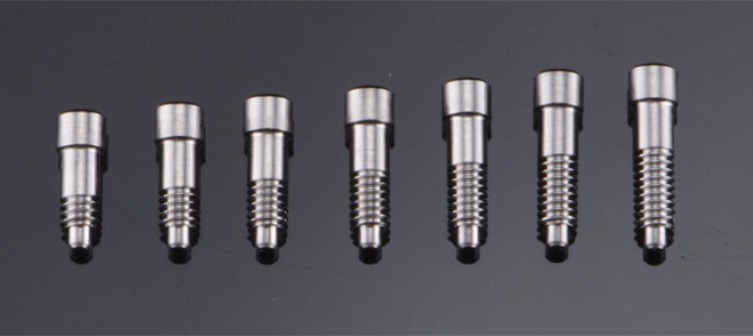
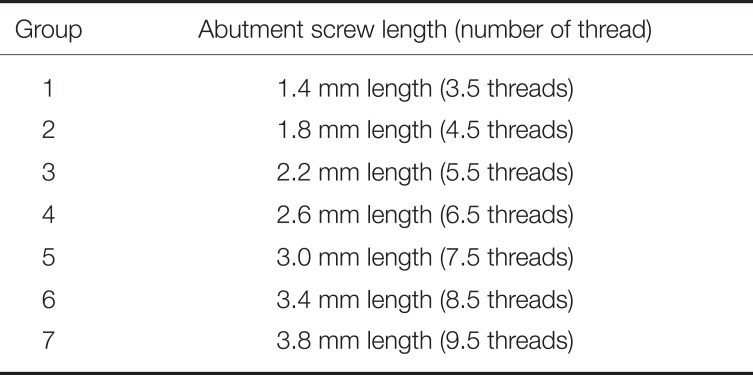

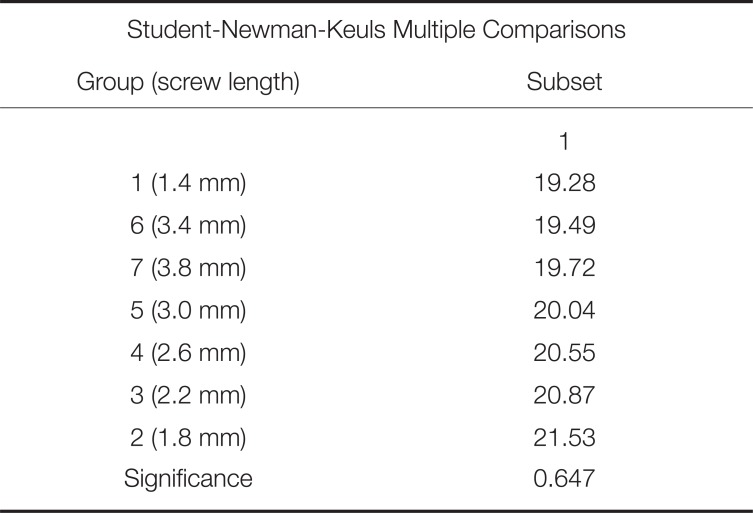
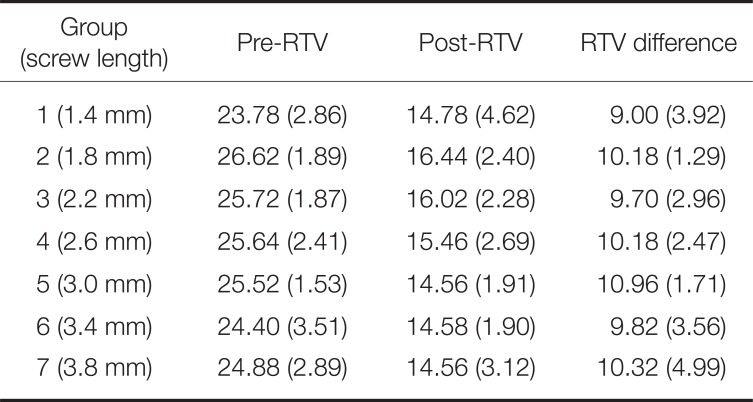




 PDF
PDF ePub
ePub Citation
Citation Print
Print




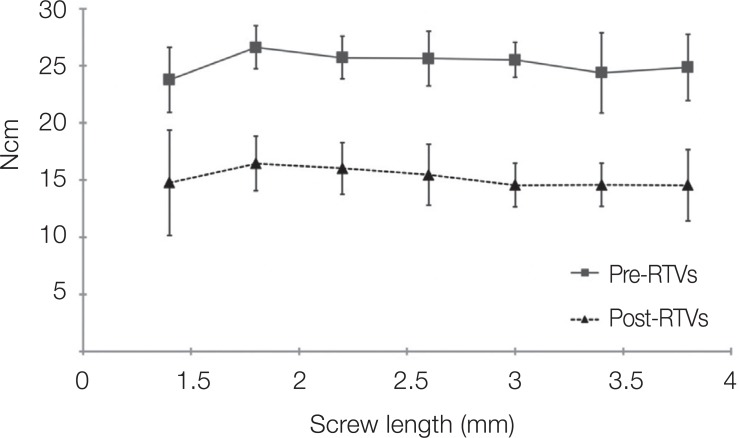

 XML Download
XML Download